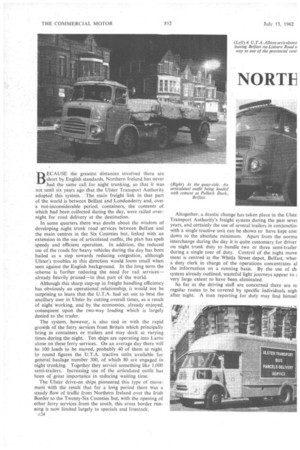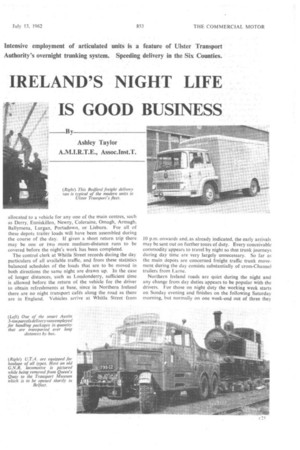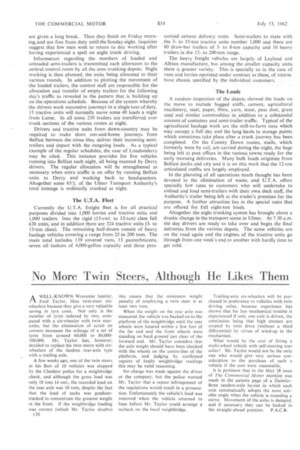NORTF IRELAND'S NIGHT LIFE IS GOOD BUSINESS
Page 54

Page 55

Page 56

If you've noticed an error in this article please click here to report it so we can fix it.
By Ashley Taylor A.M.I.R.T.E., Associnst.T.
BECAUSE the greatest distances involved there are short by English standards, Northern Ireland has never had the same call for night trunking, so that it was not until six years ago that the Ulster Transport Authority adopted this system. The main freight link in that part of the world is between Belfast and Londonderry and, over a not-inconsiderable period, containers, the contents of which had been collected during the day, were railed overnight for road delivery at the destination.
In some quarters there was doubt about the wisdom of developing night trunk road services between Belfast and the main centres in the Six Counties but, linked with an extension in the use of articulated outfits, the plan has spelt speedy and efficient operation. In addition, the reduced use of the roads for heavy vehicles during the day has been hailed as a step towards reducing congestion, although Ulster's iroubles in this direction would loom small when seen against the English background. In the long term the scheme is further reducing the need for rail services— already heavily pruned—in that part of the world.
. Although this sharp step-up in freight handling efficiency has obviously an operational relationship, it would not be surprising to learn that the U.T.A. had set out to beat the ancillary user in Ulster by cutting overall times, as a result of night working, and by the economies, already enjoyed, consequent upon the two-way loading which is largely denied to the trader.
The system, however, is also tied in with the rapid growth of the ferry services from Britain which principally bring in containers or trailers and May dock at varying times during the night. , Ton ships are operating into Lame alone on these ferry services. On an average day there will be 100 loads to be moved,probably 40 of them. at night. In round . figures the U.T.A. tractive units available for general haulage number 300, of which 80 are engaged in night trunking. Together they service something like 1,000 semi trailers Increasing use of the articulated outfit has been of great importance in reducing waiting time.
The Ulster drive-on. ships pioneered this type of move ment . ment with the result that for a long period there was a steady flow of traffic from Northern Ireland over the Irish Border to the Twenty-Six Counties but, with the opening of other ferry services :from the south, this cross border running is now limited largely to specials and livestock.
c24
Altogether, a drastic change has taken place in the Ulste Transport Authority's freight system during the past sevei years, and certainly the use of several trailers in con junctioi with a single tractive unit can be shown to have kept cost down to the absolute minimum. Apart from the norma interchange during the day it is quite customary for driver: on night trunk duty to handle two or three semi-trailer during a single tour of duty. Control of the night move ment is centred at the Whitla Street depot, Belfast, wher, a duty clerk in charge of the operations concentrates al the information on a running basis. By the use of thi system already outlined, wasteful light journeys appear to very large extent to have been eliminated.
So far as the driving staff are concerned there are nc regular routes to be covered by specific individuals nigh after night. A man reporting for duty may find hirrisel allocated to a vehicle for any one of the main centres, such as Derry, Enniskillen, Newry, Coleraine, Omagh, Armagh, Ballymena, Lurgan, Portadown, or Lisburn. For all of these depots trailer loads will have been assembled during the course of the day. If given a short return trip there may be one or two more medium-distance runs to be covered before the night's work has been completed.
The control clerk at Whitla Street records during the day particulars of all available traffic, and from these statistics balanced schedules of the loads that are to be moved in both directions the same night are drawn up. In the case of longer distances, such as Londonderry, sufficient time is allowed before the return of the vehicle for the driver to obtain refreshments at base, since in Northern Ireland there are no night transport cafés along the road as there are in England. Vehicles arrive at Whitla Street from
JO p.m. onwards and, as already indicated, the early arrivals may be sent out on further tours of duty. Every conceivable commodity appears to travel by night so that trunk journeys during day time are very largely unnecessary. So far as the main depots are concerned freight traffic trunk movement during the day consists substantially of cross-Channel trailers from Lame.
Northern Ireland roads are quiet during the night and any change from day duties appears to be popular with the drivers. For those on night duty the working week starts on Sunday evening and finishes on the following Saturday morning, but normally on one week-end out of three they are given a long break. Then they finish on Friday morning, and are free from duty until the Sunday night. Inquiries suggest that few men wish to return to day working after having experienced a spell on night trunk driving.
Information regarding the numbers of loaded and unloaded semi-trailers is transmitted each afternoon to the central control room by all the area trunking depots. Night working is then planned, the units being allocated to their various rounds. In addition to plotting the movement of the loaded trailers, the control staff are responsible for the allocation and transfer of empty trailers for the following day's traffic as revealed in the pattern that is building up on the operations schedule. Because of the system whereby the drivers work successive journeys in a single tour of duty, 15 tractive units will normally move some 40 loads a night from Lame. In all some 250 trailers are transferred over trunk sections of the various routes at night.
Drivers and tractive units from down-country may be required to make short out-and-home journeys from Belfast between the times they deliver their incoming semitrailers and depart with the outgoing loads. As a typical example of the regular schedules, the case of Londonderry may be cited. This instance provides for five vehicles running into Belfast each night, all being manned by Derry drivers. The regular allocation will be strengthened as necessary when extra traffic is on offer by running Belfast units to Derry and working back to headquarters. Altogether some 65% of the Ulster Transport Authority's total tonnage is ordinarily trunked at night.
The U.T.A. Fleet Currently the U.T.A. freight fleet is for all practical purposes divided into 1,000 lorries and tractive units and 1,090 trailers. Into the rigid (15-cwt. to 12-ton) class fall 670 units, and in addition there are 324 tractive units (3to 15-ton class). The remaining half-dozen consist of heavy haulage vehicles covering a range from 25 to 200 tons. The main total includes 139 covered vans, 13 pantechnicons, seven oil tankers of 4,000-gallon capacity and three pres surized cement delivery units. Semi-trailers to mate with the 3, to 15-ton tractive units number 1,000 and there are 80 draw-bar trailers of 3to '8-ton capacity and 10 heavy trailers in the 15-.to 200-ton range.
The heavy freight vehicles are largely of Leyland and Albion manufacture, but among the smaller capacity units there is greater variety. This is specially so in the case of vans and lorries operated under contract as these, of course. have chassis specified by the individual customers. :
The Loads A random inspection of the depots showed the loads on the move to include bagged stuffs, cement, agricultural machinery, steel, paper, fibre, yarn, stout, peat dust, grass seed and similar commodities in addition to a substantial amount of container and semi-trailer traffic. Typical of the agricultural haulage work are the mill-to-farm runs which may occupy a full day and the long hauls to storage points which sometimes take place after a trunk journey has been completed. On the County Down routes, mails, which formerly went by rail, are carried during the night, the bags • being left at post offices in the various towns ready for the early morning deliveries. Many bulk loads originate from Belfast docks and city and it is on this work that the 12-ton articulated outfits are largely employed.
In the planning of all operations much thought has been devoted to the elimination of waste, and U.T.A. offers specially !ow rates to customers who will undertake to unload and load semi-trailers with their own deck staff, the Authority's trailer being left at the trader's premises for the purpose. A further attraction lies in the special rates that are offered for full eight-ton loads.
Altogether the night trunking system has brought about a drastic change in the transport scene in Ulster. At 7.30 a.m. • the day drivers are ready to take over and begin the final deliveries from the various depots. The same vehicles are on the road again and the engines of the tractive units go through from one week's end to another with hardly time to get cold.












































































































